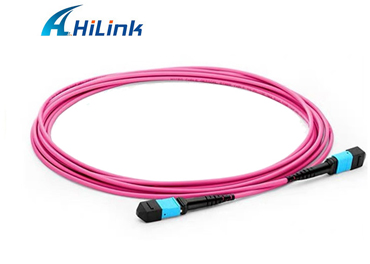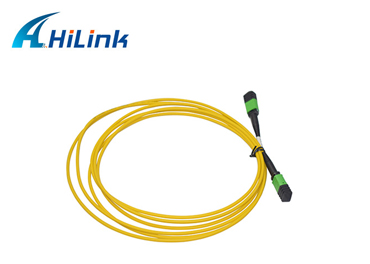Applications of MTP/MPO Cable Types in 5 Performances
Mar. 17, 2023
As data centers handle larger and larger bandwidths and network connections, traditional dual-fiber patch cables like LC cables can no longer meet the demand. To solve this problem, MTP/MPO fiber optic cables that hold more fibers in a single multi-conductor MTP/MPO connector have emerged in the market, which is proving to be a practical solution for 40G/100G/400G high-density cabling in data centers. This article will introduce the different MTP/MPO cable types and their applications.
What is MTP/MPO cable?
MPO (Multi-Fiber Push-on) is the first generation of clamp-on multi-conductor fiber optic connectors.MTP® is a registered trademark of Conec Ltd. in the USA and is an upgraded version of MPO with better mechanical and optical properties. They look alike and are fully compatible and intermateable.There are three types of MTP/MPO cables: MTP/MPO trunk cable, MTP/MPO harness cable, and MTP/MPO conversion cable.
MTP/MPO fiber optic cable consists of MTP/MPO connectors and fiber optics. mtp/mpo connectors are available in female (pinless) or male (pinned) versions. mtp/mpo connectors greatly increase cable density, save circuit cards and rack space, and are ideal for current 40g/100g cabling and future network speed upgrades.
MTP/MPO Patch Cord Cables
MTP/MPO cable types in 5 gigs
MTP/MPO cable types are determined by 5 main properties, including function, polarity, number of fibers, fiber mode, and jacket grade. A variety of MTP/MPO cables are available for different application environments and requirements.
By Function
The three MTP/MPO cable types - trunk cable, MTP/MPO branch cable and MTP/MPO conversion cable - are ideally suited for high-density cabling networks, providing better network capacity and flexibility.
MTP/MPO Trunk Cable
MTP/MPO trunk cables are terminated at both ends with MTP/MPO connectors (female/male) and are available in 8-144 cores for users to choose from. Typically, these multi-fiber MTP/MPO trunk cables are ideal for creating structured cabling systems, including backbone and horizontal interconnects such as 40G-40G and 100G-100G direct connections.
MTP/MPO Branch Cables
MTP/MPO branch cables (also known as harness cables or fan-out cables) terminate with a female/male MTP/MPO connector on one end and a 4/6/8/12 duplex LC/FC/SC/ST connector on the other end, such as 8-conductor MTP/MPO to 4 LC harness cables and 12-conductor MTP/MPO to 6 LC harness cables. Typically, these branch cables are ideal for short distance 10G-40G and 25G-100G direct connections, or for connecting backbone components to rack systems in high density backbone cabling.
MTP/MPO Patch Cord Cables
MTP/MPO Conversion Cables
MTP/MPO conversion cables have the same fan-out design as MTP/MPO branch cables, but with a different number and type of fibers. They come with MTP/MPO connectors on both ends. Specifically, the commonly used MTP/MPO conversion cables are 24-fiber to 2×12-fiber, 24-fiber to 3×8-fiber, and 2×12-fiber to 3×8-fiber. They are especially suitable for 10G-40G, 40G-40G, 40G-100G, 40G-120G connections, which can eliminate fiber waste and greatly improve the flexibility of MTP/MPO cabling systems.
By Polarity
The MTP/MPO cable type by polarity refers to the difference between the optical transmitter and receiver at each end of the fiber link. Due to the special design of MTP/MPO connectors, polarity must be addressed in high-density MTP/MPO cabling systems.
The TIA 568 standard defines three types of connections to ensure the correct polarity of the optical path, called Type A, Type B and Type C. These three MTP/MPO connector types have different cable constructions.
By fiber count
The different core counts of MTP/MPO cables are classified as 8 core/12 core/24 core, which are usually used for 40G/100G. The latest 16 core fiber optic cables are designed for short distance 400G cabling in hyperscale data centers.
The 8-conductor MTP/MPO cable system can transmit the same data rate as 12-conductor cable, but at a lower cost and insertion loss, making it more cost effective.
The 12 core MTP/MPO cable was the first developed and most commonly used solution for 10G-40G and 40G-100G connections. When used in 40G QSFP+ or 100G QSFP28 transceivers, there are 4 fibers left unused, resulting in low fiber utilization.
24 core MTP/MPO cables are typically used to create 100GBASE-SR10 links between CFP to CFP transceivers.
16-cell MTP/MPO cables use the same external dimensions as traditional 12-cell MT (mechanically transferable) inserts, aggregating multiple 8-cell parallel transceivers and coupling directly to emerging 16-cell parallel fiber links such as 400G QSFP-DD and OSFP.
By Fiber Mode
According to Fiber Mode, MTP/MPO cable types include multimode OM3/OM4 and single-mode OS2 cables. Multimode OM3/OM4 MTP/MPO cables are suitable for short distance transmission, allowing 40 Git/s maximum transmission distance of 100m or 150m respectively. Single-mode OS2 MTP/MPO cables are suitable for long-distance transmission, such as in Metropolitan Area Networks (MANs) and PONs (Passive Optical Networks). With less modal dispersion, the bandwidth of OS2 is higher than OM3/OM4.
By Jacket Rating
According to different fire rating requirements, the jackets of MTP/MPO cable types are classified as LSZH (Low Smoke Zero Halogen), OFNP (Optical Fiber Nonconductive, Plenum), CMP (Communications Multipurpose Cable, Plenum) etc.
LSZH MTP/MPO cables are free of halogenated materials (toxic and corrosive during combustion), which can better protect personnel and equipment during fires and are suitable for closed places.
OFNP MTP/MPO cables contain no electrically conductive elements and are designed with the highest fire rating, which can be installed in ducts, plenums and other spaces for building airflow.
CMP MTP/MPO cables can restrict flame propagation and smoke exhaust rate during a fire, which are suitable for plenum spaces, where air circulation for heating and air conditioning systems are facilitated.
Conclusion
The MTP/MPO cable types distinguished by five features make it easier to filter out the network connection solution that suits specific needs. MTP/MPO cables are well-received for high-density cabling in data centers, as they are capable of accommodating multi fibers within a single interface, which largely increases network capacity, saves a lot of space and offers ease of cable management.













